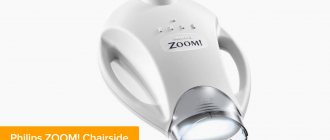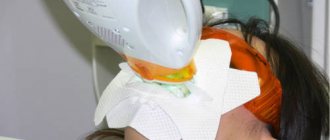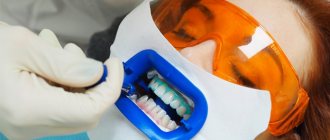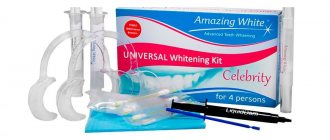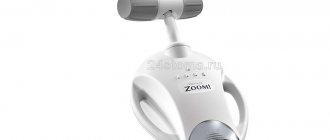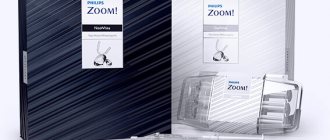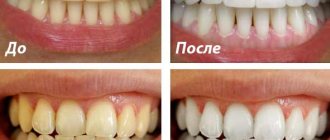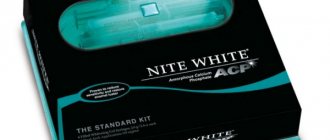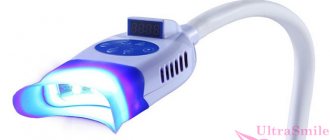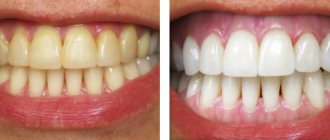Features of teeth whitening Zoom 4
Zoom technology is patented by Discus Dental. The essence of the method is as follows: a special gel is applied to the surface of the teeth, the action of which is activated by the light of an ultraviolet lamp. As a result of light exposure, oxygen molecules are released, which penetrate dental tissue and destroy coloring pigments.
Zoom 4 whitening technology, which is the latest version of Philips' development, features a number of solutions that significantly increase the comfort and safety of the procedure.
Content:
Zoom 4 is an updated technology of one of the most popular professional teeth whitening systems from Philips. The improved system is considered the safest compared to previous ones, as it contains 10% less hydrogen peroxide (only 25%). The developers of the updated Zoom 4 system managed to find the optimal balance between the effectiveness and safety of whitening. Thanks to this, tooth enamel does not deteriorate or crack.
Zoom 4 is the most effective and safe teeth whitening technology available today. The Zoom 4 technology showed the greatest whitening effect when the enamel darkened due to smoking or consumption of food coloring. The Zoom whitening technique was created in the USA, and, thanks to its many advantages, very soon became popular in other countries.
Benefits of Philips Zoom 4 Teeth Whitening
The most effective and gentle whitening - under this motto, Philips launched its new product on the market. The Zoom 4 kit includes an LED lamp with various intensity settings, Philips ZOOM! Chairside, as well as Relief ACP tooth sensitivity reducer. Previous generation systems have a similar set of components. However, the old composition of the whitening gel could not be called ideal. In Zoom 4 it was seriously improved, which helped reduce the negative impact on dental tissue.
Is Zoom 4 teeth whitening harmful?
Any type of whitening is safe if it is performed by a qualified professional following protocol, as well as certified equipment and supplies.
pros
- The hydrogen peroxide content is 25%, which is the lowest level compared to previous Zoom systems.
- The whitening gel contains calcium phosphate to restore enamel.
- Philips ZOOM! Chairside does not overheat dental tissue and has a flexible system of settings.
- To prevent tooth sensitivity, an effective remedy is used - Relief ACP gel.
- The procedure takes on average no more than 45 minutes.
The whitening procedure itself is carried out in several successive stages:
- A two-component gel is applied to the “smile zone” (10 lower and 10 upper dental units). It contains hydrogen peroxide and an alkaline component;
- exposure is carried out using a UV lamp. This allows the hydrogen peroxide activity to start. Duration of exposure – 15-20 minutes;
- after this period, the teeth are processed again if the desired result is not achieved. In the vast majority of cases, two applications are sufficient;
- At the last stage, the teeth are treated with a remineralizing gel. It contains amorphous calcium phosphate, which restores enamel and reduces sensitivity.
The clinic employs highly qualified specialists who take prizes in All-Russian competitions.
They have enormous experience and practical skills in solving problems of varying complexity.
Differences between Zoom 4 and Zoom 3
There are no conceptual differences between two generations of the same technology. It's all about the nuances.
✔
Firstly, all components and tools of Zoom 4 are from one manufacturer. Their maximum compatibility allows you to achieve the best results.
✔
Secondly, the Zoom 4 whitening gel contains a number of additional elements that reduce the negative impact on the enamel and promote its active restoration.
✔
In addition, Zoom 4 contains less hydrogen peroxide: 25% versus 35% in Zoom 3. This ten percent difference is very important. The alkaline composition, which is applied along with the gel, helps to minimize this impact.
Thanks to the balanced composition and the introduction of new developments, hypersensitivity after teeth whitening with the Zoom 4 system can be observed for only 7-10 hours, after which the patient practically does not feel any serious discomfort. In terms of safety, comfort and painlessness, Zoom 4 is superior to Zoom 3, not to mention earlier systems. On the other hand, the efficiency of Zoom 3 is about the same as that of Zoom 4.
Types of Zoom whitening
There are several varieties of Zoom photobleaching technology that differ across generations. A total of three generations have been developed, which have some features. Zoom technologies of the first and second generations are practically no different from each other. During them, whitening gels with a certain content of hydrogen peroxide were used. These lightening methods presented some danger to the tooth structure. The thing is that hydrogen peroxide in high concentrations had an aggressive effect on the structure of the teeth and washed away all useful minerals. As a result, this all led to premature wear of the tooth enamel. After some time, Zoom 3 technology appeared. This is a more advanced technology, which eliminated all the shortcomings of previous generations of photobleaching. This made the lightening method comfortable and safe.
There are several similar systems: Zoom, Zoom 2, and Zoom 3. The last option is considered the most effective, because in this case a longer light wave is used, which reduces the duration of the procedure.
Distinctive features of Zoom 3:
- For bleaching, reagents and a lamp are used, which are manufactured by the same manufacturer. This ensures the compatibility of these components; the constituent elements of whitening gels can be activated only under the light of a certain lamp;
- The bleaching machine has a short service life. The service life can be extended only by replacing the ultraviolet lamp, which ensures high safety of the procedure;
- During Zoom 3, bleaching agents are used with a reduced concentration of hydrogen peroxide to 25%. Due to this, these agents do not have an aggressive effect on the structure of tooth enamel;
- Another difference of this generation is the special storage system.
Alkalizing components and hydrogen peroxide are in different syringes. Attention! Mixing the two elements is carried out during application to the enamel surface, this helps reduce the aggressive effects and avoid further tooth decay; - Before starting whitening and immediately after it, a special composition containing calcium phosphate is applied to the surface of the teeth. Due to this remedy, the enamel is quickly restored and the level of sensitivity in the teeth is reduced. This gel can be used independently at home to prevent various diseases of the oral cavity and teeth.
Advantages
It is worth considering that there are no ideal whitening methods. Even if professional lightening methods allow you to get instant results, they still have some nuances. For this reason, before starting lightening using this method, you should consult a doctor and undergo the necessary examination. The positive qualities of this method include the following advantages:
- In one photo-whitening session, you can immediately lighten your teeth by 10-12 shades. This result cannot be obtained when whitening tooth enamel at home;
- If after the procedure you stop eating foods and drinks with dyes and stop smoking, the effect can last up to 4-5 years;
- If the patient has completely healthy teeth and gums, then this whitening procedure will be completely safe for him;
- The use of a special gel with a mineralizing structure - Relief, provides an increased degree of protection of the top layer of tooth enamel;
- During this procedure, only the pigment is removed, the dentin is not affected or destroyed;
- The procedure has a short recovery period. The total duration of rehabilitation is no more than a week. During this period, it is not allowed to consume food or drinks with dyes; it is also contraindicated to eat berries, drink coffee, tea and smoke;
- The whitening effect after the procedure is visible almost immediately. Sometimes teeth do not lighten, but this is very rare and only happens very rarely (only 7%);
- The procedure is easy, with virtually no pain or discomfort.
The Zoom3 method allows you to lighten teeth for a long period, get rid of yellow cigarette or coffee and tea stains, this procedure is absolutely safe (if you have healthy teeth), the effect of the procedure is not long in coming - it appears immediately.
Flaws
Important! The main disadvantage of this procedure is that it is necessary to remain under an ultraviolet lamp with your mouth open for a long time. In addition, reviews from some patients claim that the Zoom procedure is quite painful.
But not everyone may experience pain, only those who have increased tooth sensitivity. Usually the pain goes away after two days. Also, the Zoom photobleaching procedure has other disadvantages:
- During this procedure, slight discomfort may occur, which is associated with heating of the tissues;
- if the gel accidentally gets on the gums, irritation and discomfort may occur;
- within 1-2 days after the procedure, increased sensitivity of the teeth may be observed;
- in rare cases, an over-bleaching effect may be present, this condition is explained by the presence of an unnaturally white color.
Contraindications for carrying out
You should not use the Zoom procedure if you have the following contraindications:
- In the presence of carious lesions;
- The presence of a large number of fillings, prosthetic teeth. If you do bleaching in these cases, you may end up with a non-uniform color for the entire dentition;
- Various gum diseases;
- The enamel structure is too thin;
- The presence of an increased degree of tooth sensitivity;
- Allergic reactions to the gel that is used during this whitening procedure;
- Should not be used if there are malignant tumors;
- When undergoing chemotherapy;
- It is not recommended to use while taking medications that increase the sensitivity of the skin to light;
- It is not advisable to use during pregnancy;
- When breastfeeding;
- Should not be used on children and adolescents under 18 years of age.
It is not recommended to do Zoom whitening if there are many teeth filled in the cavity, because... As a result of bleaching, the filling material will have a different shade and the teeth will be of uneven color.
How does whitening with the Zoom 4 system work?
For the procedure to be effective, preparation for Zoom 4 teeth whitening involves professional hygiene. In order to prevent increased sensitivity of teeth, remineralizing therapy is also carried out in combination with brushing. One whitening session can consist of several cycles of 10-15 minutes. After whitening, Relief gel is applied to the enamel to reduce tooth sensitivity.
Indications and contraindications
Tooth enamel changes color under the influence of medications, abuse of coloring foods and drinks, coffee, and smoking. Zoom teeth whitening allows you to restore the whiteness of tooth enamel in the event of the formation of pigment spots, age-related darkening, or staining of dentin after endodontic treatment. Teeth are lightened by 3–8 shades, but the final result depends on the original color of the enamel. Persistent pigment cannot be removed in one session.
In addition to the lightening effect, tooth enamel is compacted and cariogenic bacteria are removed, which minimizes the risk of caries development.
Reference!
Only natural tooth tissue can be whitened; crowns and fillings are not lightened and will stand out strongly against the background of white teeth. In this case, replacement of dental structures and fillings may be required.
Zoom teeth whitening is contraindicated during pregnancy and breastfeeding, and children under 18 years of age due to immature tooth enamel. Relative contraindications include diabetes mellitus and thyroid disease.
Whitening results
Several factors influence how bright and light the shade of your teeth will be. The first is smoking. The more cigarettes a patient smokes, the sooner the teeth will darken from nicotine stains. To prevent this from happening, you should either give up the bad habit or regularly undergo professional cleaning.
The second factor is the innate shade of the enamel. There are 16 of them in total, and there are teeth that are very dark by nature. The darker the natural pigment, the more effort you will have to put into bleaching.
The third factor is illness or taking medications that affect the color of teeth (fluorosis, tetracycline antibiotics, etc.). Such stains may be difficult to whiten. The whitening result will last from 3 to 5 years, provided proper and regular care (home hygiene, professional cleaning every six months).
Cost of the procedure
Having decided to use the services of the clinic, the future patient is faced with the sacramental problem of choice. The price range from three to fifteen thousand rubles will make you scratch your head.
There are two options:
- Listen to the advice of family and friends who you can trust and who have already experienced a similar operation; follow the familiar trodden path.
- Become picky and petty, study the price lists of medical institutions , discuss every detail, every included or excluded service; discuss discounts and guarantees in advance, draw up a written document.
A reasonable ratio of price, quality and safety will be the best solution.
Care and diet after teeth whitening Zoom 4
Any type of bleaching imposes a number of restrictions, the compliance with which directly determines the effectiveness of the procedure. In the case of Zoom 4 technology, it is very important to follow a diet after whitening is completed.
List of recommendations after whitening Zoom 4
- Eliminate from your diet all foods and drinks that tend to stain your teeth. First of all, these are coffee, tea, sweet carbonated drinks, wine, beets, carrots, ketchup and dark chocolate. It is advisable to avoid the above foods for at least a week.
- For two days, completely eliminate tobacco use. It is advisable to quit smoking for a month or at least significantly reduce the number of cigarettes per day.
- Comprehensive hygiene using floss, irrigator, high-quality toothbrush and toothpaste with minimal abrasiveness (at least during the recovery stage after whitening).
- Regular visits to the dentist for preventive examinations and professional hygiene.
How is whitening done?
At the first stage, the doctor needs to determine the natural and desired shade of tooth enamel. For this purpose, the standard VITA scale is used. Next, the patient is prepared for the procedure: a cream that protects from ultraviolet radiation is applied to the cheeks and lips, the gums are protected with a hardening gel, and the eyes are protected with dental glasses.
Contraindications to the use of teeth whitening method
It is not recommended to carry out the procedure in question in a number of cases, let’s consider in which:
- Persons who have not reached 16 years of age;
- Women during pregnancy;
- For oncological diseases;
- If you are allergic to the components used in whitening;
- Epileptic seizures, psychological disorders;
- If there is damage to soft tissues in the oral cavity, the presence of caries and tartar on the teeth.
Therefore, before we decide to buy the drug, it is recommended to consult a specialist. If you have no contraindications, feel free to contact our company and order a teeth whitening gel, which we will promptly deliver to you.
Preparation
The Zoom whitening procedure takes very little time, about an hour and a half. Be sure to properly prepare for it:
- about two weeks before this procedure, many patients and dentists recommend using a special Fluoridex toothpaste when cleaning their teeth, which can reduce tooth sensitivity;
- It is imperative to eliminate all kinds of dental diseases. It is recommended to eliminate bleeding gums, after which you can begin to whiten the enamel;
- In about two weeks, it is worth having a professional teeth cleaning, during which the stone will be completely removed from the surface of the teeth.
